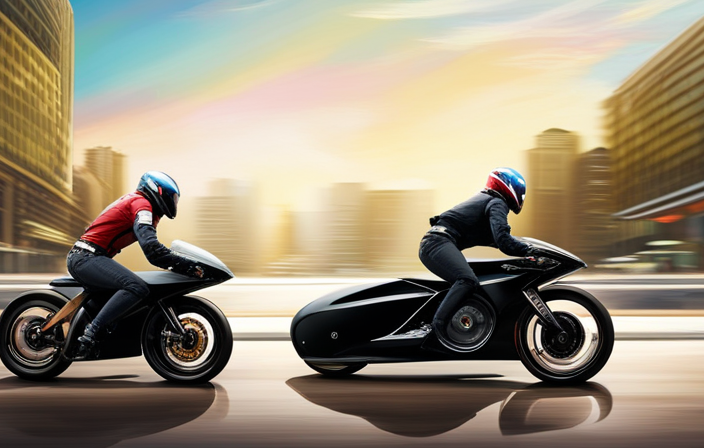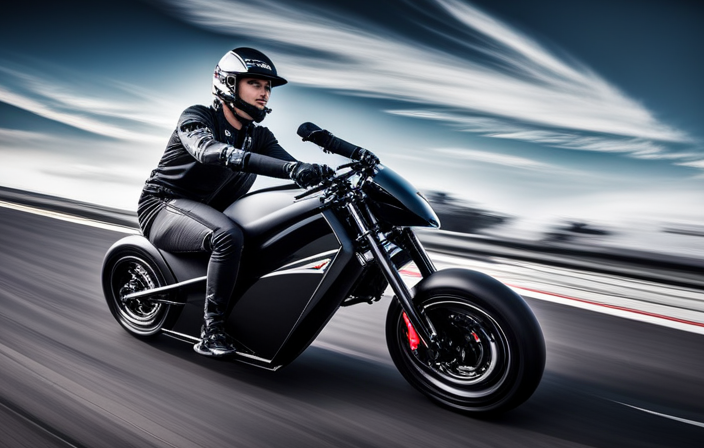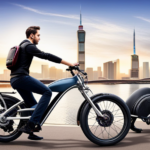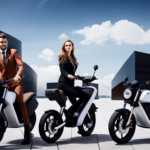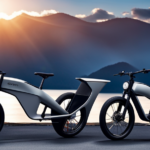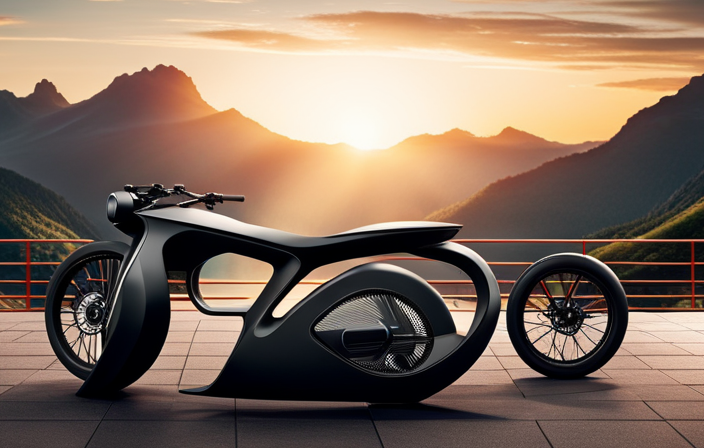Do you find yourself frustrated with traffic congestion and wasting fuel? Look no further! This article delves into the classic comparison between gas-powered bikes and electric bikes.
Which one reigns supreme in terms of performance, environmental impact, cost, convenience, health benefits, and safety? Strap on your helmet and get ready for an electrifying ride as we analyze these two modes of transportation.
It’s time to find out which bike truly deserves the title of ‘Better.’
Key Takeaways
- Both petrol bikes and electric bikes offer exercise opportunities, with petrol bikes requiring manual effort for building strength and endurance, while electric bikes provide pedal assist for less intense workouts.
- Regular cycling, regardless of the type of bike, improves physical health and mental well-being, reducing stress and boosting mood.
- Electric bikes are particularly beneficial for riders with physical limitations, as they provide assistance and make cycling more accessible and enjoyable.
- Wearing a helmet is crucial for both types of bikes, as it prevents severe head injuries and increases visibility for other road users, setting a good example for responsible riding.
Performance and Speed Comparison
The electric bike offers a smoother ride and faster acceleration compared to the petrol bike. When you ride an electric bike, you will notice the immediate torque and power that it provides. The electric motor delivers an instant burst of energy, allowing you to accelerate quickly and effortlessly. This means that you can easily keep up with traffic and navigate through congested areas more efficiently.
Additionally, electric bikes often have multiple speed settings, allowing you to adjust the power output to suit your needs. On the other hand, petrol bikes may have a slight delay in acceleration due to the combustion engine’s mechanics.
Overall, the electric bike’s superior performance and speed make it a great choice for those who value efficiency and convenience.
Moving on to the environmental impact, electric bikes have much less of an impact on the environment compared to petrol bikes.
Environmental Impact
When considering the environmental impact of transportation, there are several key points to consider.
Firstly, emissions and air pollution play a significant role in the overall impact.
Secondly, the carbon footprint of a mode of transportation is an important factor to evaluate.
Lastly, the use of renewable energy sources in transportation can greatly mitigate the environmental impact.
Emissions and Air Pollution
Did you know that electric bikes have significantly lower emissions compared to petrol bikes? Electric bikes produce zero tailpipe emissions because they run on electricity instead of petrol. This means that they do not contribute to air pollution like petrol bikes do.
Petrol bikes, on the other hand, release harmful pollutants such as carbon monoxide, nitrogen oxides, and particulate matter into the air, which can have detrimental effects on human health and the environment. By choosing an electric bike, you can help reduce air pollution and improve air quality in your community.
But emissions are just one part of the equation when considering the environmental impact of bikes. Another important factor to consider is the carbon footprint.
Carbon Footprint
By choosing an electric bike, you’re making a positive impact on your carbon footprint. Electric bikes produce zero tailpipe emissions, which means they don’t release harmful pollutants into the air like petrol bikes do. This is significant because transportation is one of the largest contributors to greenhouse gas emissions.
By opting for an electric bike, you can reduce your carbon emissions and help combat climate change. Electric bikes are powered by rechargeable batteries, which can be charged using electricity from renewable energy sources such as solar or wind power.
This means that not only are you reducing your carbon footprint by riding an electric bike, but you can also potentially use renewable energy to charge it, further minimizing your environmental impact.
Renewable Energy Sources
Using renewable energy sources such as solar or wind power to charge your electric bike can further minimize your environmental impact. By harnessing the power of the sun or wind, you can generate clean and sustainable energy to power your electric bike.
Solar panels can be installed on your roof or in your backyard, converting sunlight into usable electricity. Wind turbines, on the other hand, can be set up in open areas with consistent wind flow. Both options provide a green alternative to traditional electricity sources, reducing greenhouse gas emissions and dependence on fossil fuels.
Not only will you be reducing your carbon footprint by riding an electric bike, but by charging it with renewable energy, you can ensure that your transportation choice remains eco-friendly.
Now, let’s explore some cost considerations when it comes to owning an electric bike.
Cost Considerations
When comparing the cost of a petrol bike to an electric bike, it’s important to consider factors such as maintenance and fuel expenses.
In terms of maintenance, electric bikes have an advantage. They have fewer moving parts compared to petrol bikes, which means less wear and tear and lower maintenance costs. Additionally, electric bikes do not require frequent oil changes or tune-ups, further reducing maintenance expenses.
Fuel expenses are another significant factor to consider. Electric bikes are powered by electricity, which is generally cheaper than petrol. Charging an electric bike costs significantly less than filling up a petrol bike. This cost-saving aspect makes electric bikes more economical in the long run.
Transitioning into the next section about convenience and practicality, it’s worth noting that electric bikes are also easier to charge and have a longer range compared to petrol bikes.
Convenience and Practicality
When considering the convenience and practicality of electric bikes, it is important to examine several key factors.
First, the availability and accessibility of fueling and charging infrastructure are crucial in determining the ease of using an electric bike.
Additionally, the storage and transportation options for electric bikes should be considered, as they may differ from traditional petrol bikes.
Lastly, the noise and vibration levels of electric bikes compared to petrol bikes can impact the overall user experience.
Fueling and Charging Infrastructure
The availability of fueling and charging infrastructure significantly impacts the convenience and practicality of both petrol bikes and electric bikes.
When it comes to petrol bikes, fueling stations are widespread and easily accessible, allowing you to quickly refill your tank and continue on your journey.
On the other hand, electric bikes rely on charging stations, which are not as prevalent as petrol stations. This means that finding a charging point may require some planning and may not be as convenient as refueling a petrol bike. However, with the increasing popularity of electric bikes, the number of charging stations is also on the rise.
As the infrastructure improves, the convenience of charging an electric bike will also increase.
This transition to the next section about ‘storage and transportation’ is seamless, as you consider the practicality of storing and transporting petrol and electric bikes.
Storage and Transportation
To make storing and transporting your bike easier, consider investing in a bike rack or storage solution.
A bike rack attaches to your vehicle, allowing you to securely transport your bike without taking up valuable space inside your car. There are various types of bike racks available, such as roof racks, trunk-mounted racks, and hitch-mounted racks.
Roof racks are ideal if you have limited trunk space or if you frequently travel with multiple bikes. Trunk-mounted racks are easy to install and remove, making them a convenient option for occasional use. Hitch-mounted racks are sturdy and provide easy access to your bike.
Whichever option you choose, make sure it is compatible with your bike and vehicle.
Now, let’s explore the noise and vibration levels of petrol bikes versus electric bikes.
Noise and Vibration Levels
Investing in a bike rack or storage solution can make storing and transporting your bike easier, while also minimizing noise and vibration levels. Here are four reasons why this is important:
-
Noise reduction: By securely storing your bike on a rack or in a storage solution, you can prevent it from making unnecessary noise. This is especially important if you live in an apartment or have neighbors who are sensitive to loud sounds.
-
Vibration control: A good bike rack or storage solution will also help to minimize vibrations when you’re transporting your bike. This can improve your overall riding experience and reduce the risk of damage to your bike.
-
Convenience: Having a dedicated storage solution means you don’t have to worry about finding a suitable place to keep your bike. It’s always ready to go whenever you are.
-
Space-saving: Bike racks and storage solutions are designed to optimize space. Whether you have a small apartment or a garage, these solutions can help you make the most of your available space.
Health and Fitness Benefits
When it comes to the topic of health and fitness benefits, there are several key points to consider.
First and foremost, engaging in physical activity and exercise is crucial for maintaining a healthy lifestyle. Not only does it help improve your physical well-being, but it also has numerous positive effects on your mental health, such as reducing stress and improving overall cognitive function.
Additionally, accessibility and inclusivity should be emphasized, as everyone should have equal opportunities to participate in activities that promote health and well-being.
Physical Activity and Exercise
Physical activity and exercise can greatly improve your overall health and well-being, so it’s important to consider how each type of bike can contribute to your fitness goals.
When it comes to physical activity, both petrol bikes and electric bikes provide opportunities for exercise. Riding a petrol bike requires more effort as you have to manually pedal and control the bike’s speed. This can help in building strength and endurance.
On the other hand, electric bikes offer pedal assist, which can make your workout less intense but still provide a good cardiovascular workout.
Whether you choose a petrol bike or an electric bike, incorporating regular cycling into your fitness routine can help you achieve your fitness goals and improve your physical health.
Furthermore, the benefits extend beyond physical fitness, as cycling can also lead to reduced stress and improved mental health.
Reduced Stress and Improved Mental Health
Cycling regularly can have a positive impact on your mental well-being. It can help reduce stress and improve overall mental health. Here are a few reasons why:
-
Increased release of endorphins: Cycling stimulates the release of endorphins, which are natural mood-boosting chemicals in your brain.
-
Stress reduction: Engaging in physical activity like cycling can help alleviate stress and anxiety by providing a healthy outlet for pent-up emotions.
-
Improved sleep: Regular cycling can lead to better sleep quality, which is crucial for maintaining good mental health.
-
Enhanced self-esteem: Achieving personal goals and feeling a sense of accomplishment through cycling can boost your self-esteem and confidence.
By incorporating cycling into your routine, you can experience these mental health benefits.
Moreover, cycling is an accessible and inclusive activity that can be enjoyed by people of all ages and fitness levels. Transitioning into the subsequent section about ‘accessibility and inclusivity,’ we can explore how cycling can be enjoyed by everyone, regardless of their physical abilities or limitations.
Accessibility and Inclusivity
By incorporating cycling into your routine, you can experience the inclusive and accessible nature of this activity.
Cycling is a form of transportation that can be enjoyed by people of all ages and abilities. Whether you are commuting to work, running errands, or simply going for a leisurely ride, cycling provides a means of transportation that is accessible to everyone.
Unlike other forms of transportation, cycling does not require a driver’s license or a specific level of physical fitness. Electric bikes, in particular, have made cycling even more accessible by providing assistance to riders who may have physical limitations. With electric bikes, you can enjoy the benefits of cycling without worrying about getting tired or exerting too much effort.
Now, let’s explore the importance of safety and security when it comes to cycling.
Safety and Security
For safety and security, you should always wear a helmet while riding your electric bike. Helmets provide essential protection for your head in case of accidents or falls. Here are some reasons why wearing a helmet is crucial:
-
Prevent head injuries: A helmet acts as a barrier between your head and the hard surface, reducing the risk of severe head injuries.
-
Increase visibility: Many helmets come with reflective strips or lights, making you more visible to other road users, especially during low light conditions.
-
Set a good example: By wearing a helmet, you encourage others to prioritize their safety and inspire a culture of responsible riding.
Conclusion
In conclusion, when it comes to comparing petrol bikes and electric bikes, it is clear that the latter is the superior choice.
With lightning-fast speeds, negligible environmental impact, and cost-effective operation, electric bikes reign supreme.
Not to mention the convenience and practicality they offer, along with the added health and fitness benefits.
Safety and security are also heightened with electric bikes.
So, why settle for a dull and outdated petrol bike when you can embrace the electrifying power and efficiency of an electric bike?
The choice is clear, go electric!
